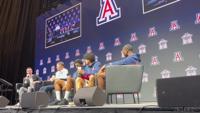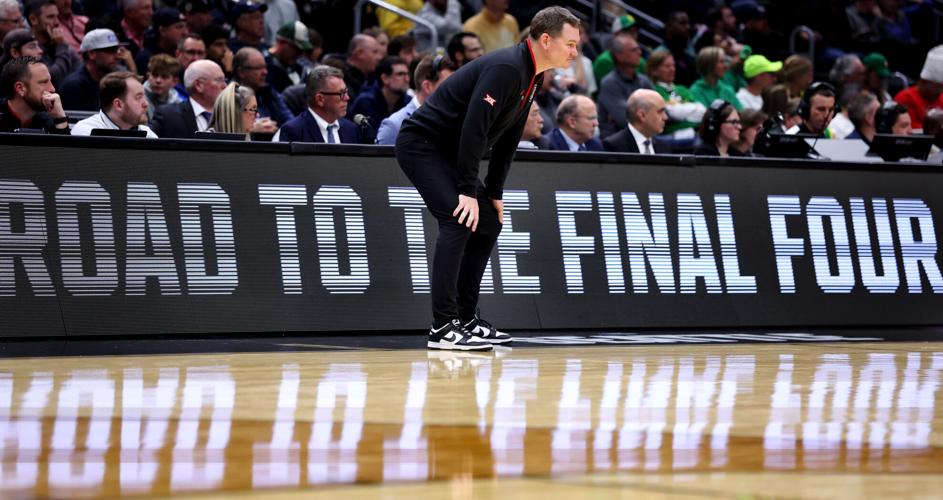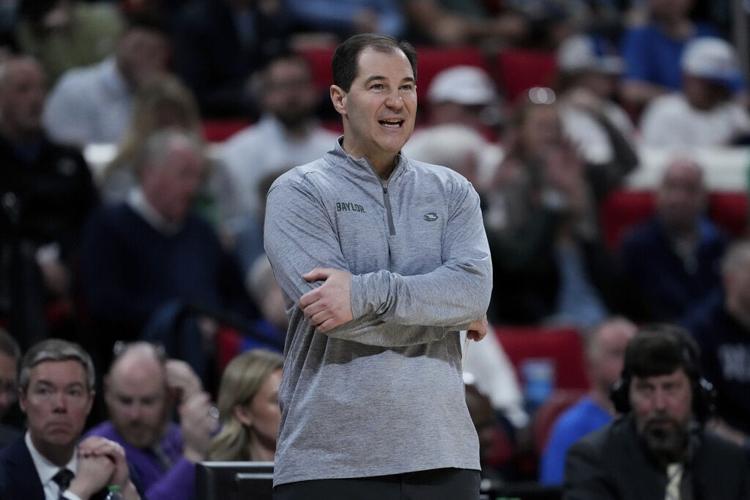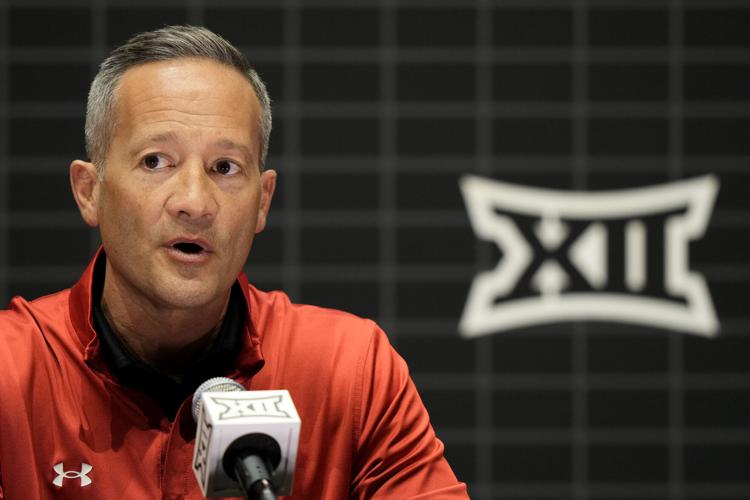KANSAS CITY, Mo.┬ĀŌĆö While watching an NBA opener between the Houston Rockets and Oklahoma City Thunder last week, Baylor coach Scott Drew said he wondered if there were any players involved that he could maybe pick up.
ŌĆ£I mean, who knows?ŌĆØ Drew said, chuckling.

Baylor head coach Scott Drew watches during the first half in the first round of the NCAA Tournament against Mississippi State, March 21, 2025, in Raleigh, N.C.┬Ā
He was joking, of course, but, actually ... who knows?
Over the past month, the NCAA has approved college eligibility for two former G League players, Louisville-bound London Johnson and new Santa Clara player Thierry Darlan, moves that further stunned an already shell-shocked group of coaches who gathered for Big 12 media day this week at a time when their sport continues to transition awkwardly away from amateurism.
If the NCAA approved the G League playersŌĆÖ eligibility because the organization feared being sued again┬ĀŌĆö a theory Michigan State coach Tom Izzo expressed during Big Ten media day┬ĀŌĆö┬ĀwhoŌĆÖs to say any former pro player who hasn't played the four allowable college seasons can't enroll somewhere, play college basketball and pick up a school-paid ŌĆ£revenue shareŌĆØ salary along the way?
People are also reading…
Or whoŌĆÖs to say somebody wonŌĆÖt sue to prevent the College Sports Commission and its NIL GO clearinghouse system for scrutinizing all NIL deals over $600? The NIL GO's mission is to ferret out disguised pay-for-play arrangements between players and booster-paid collectives but litigation is expected over antitrust concerns and the legality of limiting player compensation.
And if such a lawsuit is successful, who's to say NIL payments wonŌĆÖt again revert back to market forces, the way they did last spring when agents and schools crammed in seven-figure deals for college basketball players before the House settlementŌĆÖs approval gave birth to NIL GO?
ŌĆ£The worst thing that happened was it all started in the first place without having any guardrails at all,ŌĆØ ASU coach Bobby Hurley said. ŌĆ£And now to try and change the game as it's happening, it's a tough thing for all people that are coming into this right now."
The game changed again over the past month. First, the NCAA gave Darlan two years of college eligibility after the Central African Republic native spent the past two in the G League. Then, just before the Big 12 media day last week, it gave Johnson two years to play in college after the Jamaican guard spent the past three bouncing around the G League.
Instead of going from college to the pros, they went from the pros to college. Or, depending on how you view it, from the pros to another pro league.
"If you asked every (college) coach a week ago 'are you able to sign G league players?' I'd be hard pressed to think it wasn't 99% saying you can't," Drew said. "Normally, if rules change, there's a lot of discussion, voting and inquiry from administrators or from coaches. And nobody likes chaos. Everybody wants some resemblance of 'These are the rules. This is the enforcement. And have at it.'"
That was the core concern aired by many Big 12 coaches this week. As high-major coaches, they all have access to a fully funded, school-paid revenue share budget┬ĀŌĆö depending on how their administrations divide up the $20.5 million maximum between sports┬ĀŌĆö and they also all have access to varying budgets of booster-driven NIL collectives.
But knowing how, when and where to use those resources is the tricky part. And what any guidelines might look next year, next month or even tomorrow.
ŌĆ£The key to this is no one knows,ŌĆØ Texas Tech coach Grant McCasland said. ŌĆ£Let's be honest: It does feel like more people are waiting to see how it all turns out, and it feels like there's more uncertainty coming before there is."

Texas Tech coach Grant McCasland, shown at the 2024-25 Big 12 media day, compared college basketball's transition from amateurism to a teenager fighting with acne and other issues, unsure what is next.┬Ā
But McCasland also said it wasn't "horrible" and spoke of a bigger picture.
"Actually, I love it, because there always needs to be change, and we're going through a really tough time," he said. ŌĆ£It's kind of like the teenage years┬ĀŌĆö your voice is cracking and youŌĆÖve got acne, it looks weird, and you don't know how this is going to end up.
"I have a lot of hope in regard to where this will end up. I just think we've got more chaos before it becomes clear.ŌĆØ
Except not everyone may have time to wait for the chaos to settle.
Hurley, for one, is on the last year of his contract and basically had to rebuild his entire roster for this season, mostly turning to international players because of what he called an ŌĆ£expensiveŌĆØ domestic transfer market.
ŌĆ£I'm looking for more answers, really,ŌĆØ Hurley said. ŌĆ£I'm not sure what is considered a legal NIL deal, how they're going to be vetted. True NIL? What does that really mean?
ŌĆ£I still feel like there's still a lot of unknown with what schools are going to operate with, and how do we try and get a somewhat level playing field?ŌĆØ
Coaches arenŌĆÖt the only ones asking the questions, either. So are the high school seniors they are recruiting who wonder why they canŌĆÖt get the same kind of NIL deals as comparably skilled players from the class of 2025 did.
Those questions have resulted in a slowing in recruitments for top class of 2026 players, many of whom are holding off until the spring signing period to see if the winds change again.
Of high school class of 2026 players ranked by 247 Sports, a group that can start signing with colleges next month, only two of the top 10 have committed to college programs, and only seven of the Top 25 have.
ŌĆ£There seems to be a lot of guys who are uncommitted,ŌĆØ TCU coach Jamie Dixon said. ŌĆ£I think we anticipated that based on colleges not knowing what their financial situation is. By rule, the collective is not involved and the number out there (for recruits) is not going to be the same.
ŌĆ£So there is some of that. And, simply put, there's less and less high school recruiting from the high major schools in the fall.ŌĆØ
Still, Arizona coach Tommy Lloyd wasn't about to declare a national trend, even as his own program is trending that way.
Lloyd signed only one player during the fall signing period last year, forward Dwayne Aristode, and he has no commitments yet from 2026 players, though it is worth noting that┬Āhe often lands international players who won't sign until they finish playing for European clubs in the spring.
ŌĆ£We're seeing (recruits hold off) but thereŌĆÖs also kids committing,ŌĆØ Lloyd said. ŌĆ£ItŌĆÖs probably dangerous to generalize it when you're actually in the business of trying to get results. I think you just have to attack everything on a case-by-case basis.ŌĆØ

Arizona head coach Tommy Lloyd watches the Wildcats defend a Zip offensive series in their game against Akron during the second half of their first-round game of the menŌĆÖs NCAA Tournament in Seattle on March 21, 2025.
Similarly, Lloyd said he wasn't interested in predicting whether or not a lawsuit or anything else might change the NIL structure at some point.
ŌĆ£That would be a colossal waste of my time, and take my attention away from where it needs to be, which is on my team and my family," Lloyd said.
But Drew was among the many others willing to give a quick assessment of where he says itŌĆÖs all likely to go: Essentially, to boundaries that arenŌĆÖt constructed by the NCAA but to boundaries like the legally binding structures that pro leagues pay their players within.
ŌĆ£From the people I've talked with, I think the collective bargaining is where it's going to end up," Drew said. "No one wants to make student-athletes employees, so there has to be a pathway to make that happen.
ŌĆ£But you see (collective bargaining) in every other league, and we're like every other league now. So why wouldn't we have what they have?ŌĆØ












